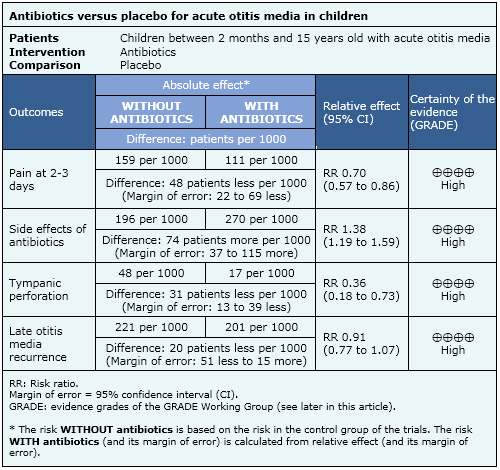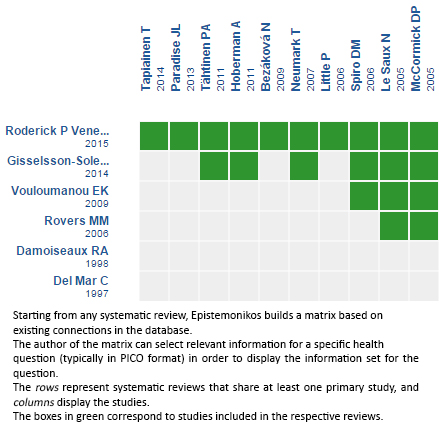Epistemonikos summaries
← vista completaPublished on October 30, 2015 | http://doi.org/10.5867/medwave.2015.6295
Antibiotics for acute otitis media in children
Antibióticos para la otitis media aguda en niños
Abstract
Acute otitis media is one of the most common infectious diseases diagnosed in children. Antibiotic treatment use remains controversial. This summary aims to evaluate the effectiveness and safety of antibiotics in children with acute otitis media. Searching in Epistemonikos database, which is maintained by screening 30 databases, we identified six systematic reviews including 18 randomized trials. We combined the evidence using meta-analysis and generated a summary of findings table following the GRADE approach. We concluded antibiotics reduce pain at 48-72 hours and reduce the risk of tympanic perforations in children with acute otitis media, but they do not reduce late recurrences and increase the risk of side effects (rash, vomiting and diarrhea).
Problem
Acute otitis media is defined as the presence of tympanic effusion (demonstrated by pneumatic otoscopy, fluid level or impedanciometry) associated with signs and symptoms of acute inflammation of the middle ear. Acute otitis media occurs more frequently in children at an early age and the most serious complications are mastoiditis, meningitis and tympanic perforation.
The use of antibiotics for the treatment of acute otitis media varies considerably among countries because its real efficacy and safety have not been determined. On one side, the expected benefits of antibiotics include reducing the number of complications, the duration of symptomatic stage and the risk of recurrences. On the other side, the inappropriate use of antibiotics can cause adverse effects and increases antibiotic resistance.
Methods
We used Epistemonikos database, which is maintained by screening more than 30 databases, to identify systematic reviews and their included primary studies. With this information, we generated a structured summary using a pre-established format, which includes key messages, a summary of the body of evidence (presented as an evidence matrix in Epistemonikos), meta-analysis of the total of studies, a summary of findings table following the GRADE approach and a table of other considerations for decision-making.
|
Key messages
|
About the body of evidence for this question
|
What is the evidence. |
We found six systematic reviews [1],[2],[3],[4],[5],[6] including 18 randomized controlled trials reported in 24 references [7],[8], [9],[10],[11],[12],[13],[14],[15],[16], [17],[18],[19],[20],[21],[22],[23],[24],[25],[26],[27],[28],[29],[30]. |
|
What types of patients were included |
The eighteen studies included patients between 2 months and 15 years. Only one study [13] included patients under 6 months, five studies [10], [17],[23],[28],[30] included only patients older than 2 years and 13 studies included patients under 2 years [7],[9],[13],[14],[15],[16],[18],[19],[21],[22],[25],[26],[27]. |
|
What types of interventions were included |
Thirteen studies evaluated the use of antibiotics versus placebo |
|
What types of outcomes |
The main outcomes reported were:
|
Summary of findings
The information about the effects of antibiotic treatment for acute otitis media is based on 18 randomized studies that included 4,550 patients. Thirteen studies compared antibiotics versus placebo [7],[9],[10],[13],[14],[15],[16],[18],[22],[26],[27],[28],[30]. Seven studies reported pain [7],[13],[16],[18],[22],[26],[28], five reported tympanic perforation [10],[14],[22],[26],[27], eight reported antibiotics side effects [1],[10],[14],[18],[22],[26],[27],[28], and six studies reported the late recurrence of acute otitis media [14],[16],[18],[22],[28],[30].
- Antibiotics reduce pain at 48-72 hours in children with acute otitis media. The certainty of the evidence is high.
- Antibiotics do not reduce late recurrences of acute otitis media. The certainty of the evidence is high.
- Antibiotics reduce the risk of tympanic perforation. The certainty of the evidence is high.
- Antibiotics increase the number of side effects (rash, vomiting and diarrhea). The certainty of the evidence is high.


Other considerations for decision-making
|
To whom this evidence does and does not apply |
|
| About the outcomes included in this summary |
|
| Balance between benefits and risks, and certainty of the evidence |
|
| What would patients and their doctors think about this intervention |
|
| Resource considerations |
|
|
Differences between this summary and other sources |
|
| Could this evidence change in the future? |
|
How we conducted this summary
Using automated and collaborative means, we compiled all the relevant evidence for the question of interest and we present it as a matrix of evidence.

Follow the link to access the interactive version: Antibiotics for acute otitis media in children
Notes
The upper portion of the matrix of evidence will display a warning of “new evidence” if new systematic reviews are published after the publication of this summary. Even though the project considers the periodical update of these summaries, users are invited to comment in Medwave or to contact the authors through email if they find new evidence and the summary should be updated earlier. After creating an account in Epistemonikos, users will be able to save the matrixes and to receive automated notifications any time new evidence potentially relevant for the question appears.
The details about the methods used to produce these summaries are described here http://dx.doi.org/10.5867/medwave.2014.06.5997.
Epistemonikos foundation is a non-for-profit organization aiming to bring information closer to health decision-makers with technology. Its main development is Epistemonikos database (www.epistemonikos.org).
These summaries follow a rigorous process of internal peer review.
Conflicts of interest
The authors do not have relevant interests to declare.

